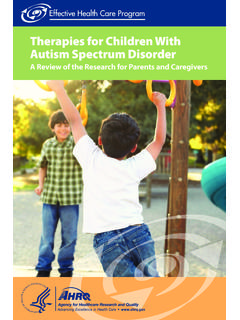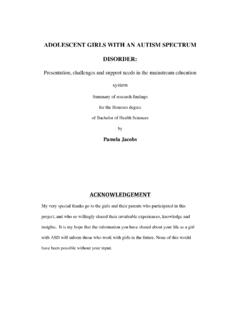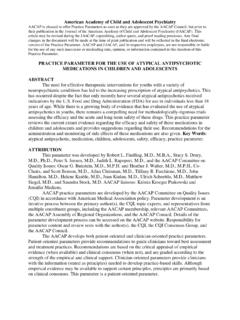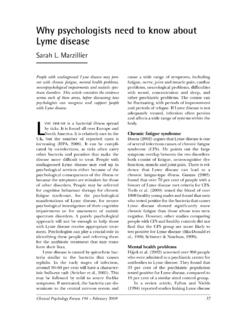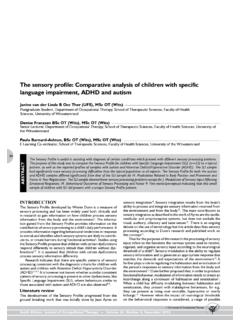Transcription of The Session Structure and Treatment Phases in …
1 1 The Session Structure and Treatment Phases in Cognitive Behavioral Therapy (CBT) for autism Spectrum Disorder (ASD) Jan-Paul Ratajczak, Habiliteringscenter Sollentuna Ung/Vux, Stockholm L ns Landsting Handledare: Katarzyna Romanowicz, Institutionen f r psykiatri och neurologi i Warszawa Utbildning: Centret f r kognitiv-beteendeterapi i Warszawa, Psykoterapeututbildning Abstract: autism spectrum disorder (ASD) is a neurodevelopmental disorder which impairs social functioning, executive functions (EF), perception/sensory and repetitive thinking patterns/behavior. Individuals with ASD often suffer from comorbid psychiatric disorders such as anxiety and depression. Findings suggest that patients with ASD might benefit from cognitive-behavioral therapy (CBT). However, research also highlight that adaptations in CBT are needed in order for more efficient Treatment of ASD.
2 This theoretical paper is based on research and clinical experience. The aim is to present issues within ASD that may interfere with CBT, proposing using the Session Structure and Treatment Phases as a way to compensate for these difficulties. 2 Introduction autism spectrum disorder (ASD) is a neurodevelopmental disorder that has been added to the most recent edition of the Diagnostic and Statistical Manual of Mental Disorders (DSM-V). In the preceding edition, DMS-IV-TR, patients could be diagnosed with four separate disorders, , Asperger s syndrome, autism , childhood disintegrative disorder and pervasive developmental disorder not otherwise specified (Black and Grant, 2014). The criteria for diagnosis include deficits in social communication and interaction, restrictive and repetitive patterns of behaviors, interests or activities.
3 Symptoms should be present in early childhood and decrease functionality in social, occupational or other domains. Nevertheless the impairments may be detected later in a person s life when social/communicational and daily demands are heightened (Friedman, Politte, Nowinski and McDougle, 2015). Adults with ASD suffer more from psychiatric disorders in comparison to general developing population. The most common comorbid psychiatric disorders in ASD are mood and anxiety disorders (Lever and Geurts, 2016). Typical problems in ASD include emotion regulation (Mazefsky et al., 2013), social skills deficits (White, 2011), executive functioning (Bramhman et al. 2016, Wallace et al 2016), sleep disturbances (Richdale, 1999), and sensory processing abnormalities (Wigham 2015). Although studies on the effectiveness (Weston, Hodgekins and Langdon, 2016) and recommended adjustment (Kerns, Roux, Connel and Shattuck, 2016) regarding CBT in ASD patients exist, there is still a lack of a comprehensive CBT Treatment manual for ASD.
4 This paper focuses on ASD without intellectual disability and typical difficulties that might interfere with individual CBT Treatment . This theoretical article is based on research and clinical experience. The aim of this paper is to propose Treatment Phases and how to use the Session Structure to compensate for typical executive function (EF) deficits. The suggested Phases presented in this paper are for instance initial phase (focusing mainly on activating 3 the patient in Session and problem-solving around CBT homework) and additional skill building (representing skill building interventions that might be used before, currently with or after individual CBT). Meta-analysis of CBT in ASD CBT focuses on explaining the relation between thoughts, behavior and emotions. By skill-building the patient increases his/her awareness regarding these relations.
5 Furthermore, patients learn to challenge dysfunctional beliefs and underlying behaviors which is essential in reducing symptoms and treating a problem. Treatment is carried out by introducing the CBT approach ( Structure ), diagnosis ( interview and measure), conceptualization ( presenting hypotheses regarding problems), Treatment plan ( behavioral goals), psychoeducation ( bibliotherapy), implementing cognitive and behavioral strategies ( cognitive restructuring and behavioral activation), homework ( caring out behavioral experiments) and relapse preventing (at the end of therapy). (Calkins, Park,Wilhelm and Sprich, 2016) A systematic review and meta-analysis was made by Weston, Hodgekins and Langdon (2016) when analyzing studies involving children, youths and adults with ASD. 48 studies where chosen after the exclusion process involving 2099 participants.
6 Findings showed a variety of effect sizes dependent on the type of report/measure used. Regarding ASD and CBT treatments of mood disorder, results based on self-report showed a small to medium non-significant effect size, while both informant-report and clinical-report data showed a significant medium effect size. With regards to CBT studies designed to treat ASD symptoms (mainly focusing on strengthening social skills, but also theory of mind, affectionate communication and facial emotions) Treatment was associated with small to medium non-significant effect sizes for self-report measures, a significant small to medium 4 effect size for informant-report measures, a significant medium effect size for clinical-report measures and a significant small to medium effect size for task-based measures. Altogether, these results indicate that CBT might be beneficial for patients with ASD, however is should be noted that most of the studies were carried out on children and adolescents.
7 Executive skills deficits in ASD Bramham et al. (2009) found that adults with ASD had impairment in initiation, planning and strategy formation. Furthermore ASD patients were slower to execute a given plan in comparison to an ADHD group and neurotypical controls. Wallace et al. (2016) made a study measuring executive functioning in adults with ASD and examining correlations with adaptive functioning and anxiety and depression. Findings suggest that adults with ASD have impairment in flexibility and planning/organization functioning. Problems regarding flexibility were associated to anxiety symptoms while problems regarding planning/organization were associated to depressive symptoms. Furthermore, executive function impairments were associated with adaptive functions difficulties. Researchers suggest that executive functions problems should be addressed during Treatment of this group.
8 They also stress that it is crucial for patient with ASD that have executive function difficulties to get support during early adulthood when external support (school and parental support) diminish and the patients might feel overwhelmed to deal with adult environment without proper compensatory strategies and tools. This notion seems to be consistent with findings where young adults with ASD had more psychiatric symptoms than elderly ASD patients (Lever and Guerts, 2016). 5 Emotion regulation in ASD patients Mazefsky et al. (2013) describe a proposed model for emotion dysregulation in ASD. The authors elaborate that contributing factors in emotion dysregulation are executive functioning deficits ( poor problem solving), function of emotion ( less organized and goal-directed emotion), affect (greater or more negative affect/irritability), altered physiological affect (possibility of hyperarousal), neural circuitry (abnormal amygdala/prefrontal cortex function and connectivity), comorbid psychiatric disorders (such as anxiety and depression), and information processing and perception (such as atypical triggers, difficulty processing social and emotional cues).
9 Suggested Phases in CBT Treatment of ASD patients Small to medium non-significant effect size in self-reports of ASD patients (Weston, Hodgekins and Langdon, 2016) and complex problems in both executive functioning (Bramham et al, 2009; Wallace et al, 2016), emotional regulation (Mazefsky et al., 2013), social skills (White, 2011) with comorbid conditions (Lever and Geurts, 2016) suggest that the patients might need adaptations in Treatment and custom-made Treatment Phases . Specific Treatment Phases have been adjusted for particular disorders and circumstances. For instance, in cognitive behavioral integrated Treatment (C-BIT) of substance abuse a total of four Treatment Phases with additional skill-building emphasis (in every phase) are used. 1) Engagement and building motivation to change, 2) negotiating some behavior change, 3) early relapse prevention and 4) relapse management (Graham, 2003).
10 Furthermore, in an inpatient dialectical behavior therapy (DBT) program three Phases are described with the following main goals for each phase 1) getting in (goal: develop an get commitment to inpatient Treatment plan), 2) getting in control (goal: reduce behavioral dyscontrol requiring hospital care) and 3) getting out (goal: develop and successfully execute discharge plan). 6 (Dimeff & Koerner, 2007) As described CBT involves a set of skills that patients learn in Treatment . The first ASD challenge for the therapy might be to cope with executive function difficulties that may interfere with Treatment and acquiring these skills. Specialists have already proposed emphasis on executive functions support for this patient group (Kerns et al., 2016). In elderly patients with general anxiety disorder (GAD), addressing both CBT and executive function training was found to be more effective than CBT alone (Mohlman, 2008).
